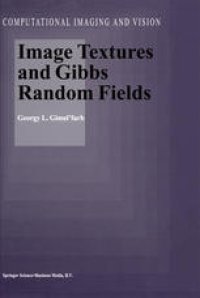
Ebook: Image Textures and Gibbs Random Fields
Author: Georgy L. Gimel’farb (auth.)
- Tags: Image Processing and Computer Vision, Computer Imaging Vision Pattern Recognition and Graphics, Artificial Intelligence (incl. Robotics), Data Structures Cryptology and Information Theory, Probability Theory and Stochastic Processes
- Series: Computational Imaging and Vision 16
- Year: 1999
- Publisher: Springer Netherlands
- Edition: 1
- Language: English
- pdf
Image analysis is one of the most challenging areas in today's computer sci ence, and image technologies are used in a host of applications. This book concentrates on image textures and presents novel techniques for their sim ulation, retrieval, and segmentation using specific Gibbs random fields with multiple pairwise interaction between signals as probabilistic image models. These models and techniques were developed mainly during the previous five years (in relation to April 1999 when these words were written). While scanning these pages you may notice that, in spite of long equa tions, the mathematical background is extremely simple. I have tried to avoid complex abstract constructions and give explicit physical (to be spe cific, "image-based") explanations to all the mathematical notions involved. Therefore it is hoped that the book can be easily read both by professionals and graduate students in computer science and electrical engineering who take an interest in image analysis and synthesis. Perhaps, mathematicians studying applications of random fields may find here some less traditional, and thus controversial, views and techniques.
This book presents novel techniques for describing image textures. Contrary to the usual practice of embedding the images to known modelling frameworks borrowed from statistical physics or other domains, this book deduces the Gibbs models from basic image features and tailors the modelling framework to the images. This approach results in more general Gibbs models than can be either Markovian or non-Markovian and possess arbitrary interaction structures and strengths. The book presents computationally feasible algorithms for parameter estimation and image simulation and demonstrates their abilities and limitations by numerous experimental results.
The book avoids too abstract mathematical constructions and gives explicit image-based explanations of all the notions involved.
Audience: The book can be read by both specialists and graduate students in computer science and electrical engineering who take an interest in texture analysis and synthesis. Also, the book may be interesting to specialists and graduate students in applied mathematics who explore random fields.
This book presents novel techniques for describing image textures. Contrary to the usual practice of embedding the images to known modelling frameworks borrowed from statistical physics or other domains, this book deduces the Gibbs models from basic image features and tailors the modelling framework to the images. This approach results in more general Gibbs models than can be either Markovian or non-Markovian and possess arbitrary interaction structures and strengths. The book presents computationally feasible algorithms for parameter estimation and image simulation and demonstrates their abilities and limitations by numerous experimental results.
The book avoids too abstract mathematical constructions and gives explicit image-based explanations of all the notions involved.
Audience: The book can be read by both specialists and graduate students in computer science and electrical engineering who take an interest in texture analysis and synthesis. Also, the book may be interesting to specialists and graduate students in applied mathematics who explore random fields.
Content:
Front Matter....Pages i-xiv
Instead of introduction....Pages 1-4
Texture, Structure, and Pairwise Interactions....Pages 5-36
Markov and Non-Markov Gibbs Image Models....Pages 37-62
Supervised MLE-Based Parameter Learning....Pages 63-100
Supervised Conditional MLE-Based Learning....Pages 101-110
Experiments in Simulating Natural Textures....Pages 111-144
Experiments in Retrieving Natural Textures....Pages 145-182
Experiments in Segmenting Natural Textures....Pages 183-238
Back Matter....Pages 239-251
This book presents novel techniques for describing image textures. Contrary to the usual practice of embedding the images to known modelling frameworks borrowed from statistical physics or other domains, this book deduces the Gibbs models from basic image features and tailors the modelling framework to the images. This approach results in more general Gibbs models than can be either Markovian or non-Markovian and possess arbitrary interaction structures and strengths. The book presents computationally feasible algorithms for parameter estimation and image simulation and demonstrates their abilities and limitations by numerous experimental results.
The book avoids too abstract mathematical constructions and gives explicit image-based explanations of all the notions involved.
Audience: The book can be read by both specialists and graduate students in computer science and electrical engineering who take an interest in texture analysis and synthesis. Also, the book may be interesting to specialists and graduate students in applied mathematics who explore random fields.
Content:
Front Matter....Pages i-xiv
Instead of introduction....Pages 1-4
Texture, Structure, and Pairwise Interactions....Pages 5-36
Markov and Non-Markov Gibbs Image Models....Pages 37-62
Supervised MLE-Based Parameter Learning....Pages 63-100
Supervised Conditional MLE-Based Learning....Pages 101-110
Experiments in Simulating Natural Textures....Pages 111-144
Experiments in Retrieving Natural Textures....Pages 145-182
Experiments in Segmenting Natural Textures....Pages 183-238
Back Matter....Pages 239-251
....